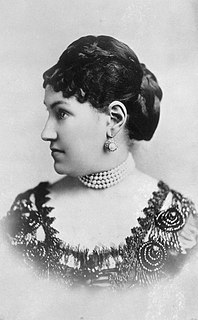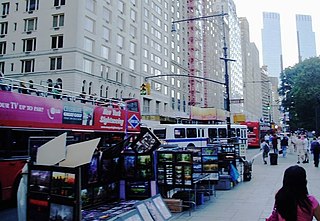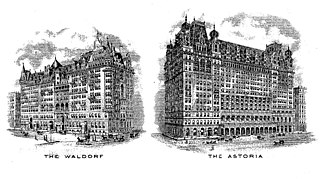
The Caspar Samler farm was a tract of land comprising the greater part of Fifth Avenue from Madison Square to 31st Street in what is now the Koreatown section of Manhattan, New York City, New York.

The Caspar Samler farm was a tract of land comprising the greater part of Fifth Avenue from Madison Square to 31st Street in what is now the Koreatown section of Manhattan, New York City, New York.
The tract of Common Lands from 28th to 32nd Streets, through which Park Avenue was later projected, was part of the 37 acres (15 ha) farm which Caspar Samler [lower-alpha 1] [2] bought in various pieces, from the City, between 1780 and 1799 for $12,100. [3] The area now known as Madison Square Garden was owned in 1780 by Samuel, Henry, and Matthias Nicoll, and it was sold to Caspar Samler for US$2,250, becoming part of the 37 acre Caspar Samler farm. [4] Three distinct Samler houses were located on the Commissioners' map of 1807. [5]
Samler had several children and one step daughter, Margaret Grenzeback. He died in 1810, and his daughter Barbara died in 1816 without having ever had children. The 5 acres, 3 roods, and 32 perches of land which were devised for her children, became therefore the property of the survivors of Samler's children or grand children according to the provision of his will. Subsequently, litigation arose as to whether the children of his step daughter Margaret Grenzeback were entitled to a portion under the designation of grandchildren. [6]

Some well-known buildings of the time later stood on the site. Among them were the Brunswick Hotel, at the northeast corner of 26th Street, once famous as the headquarters of the New York Coaching Club; and the Hotel Victoria, at the southwest corner of 27th Street, patronized at one time by Grover Cleveland, and later demolished to make way for a 20-story business structure. The Marble Collegiate Church at 29th Street and the Holland House at 30th Street also stood on sites once part of the Samler farm. [7]
North of the Caspar Samler farm, extending on Fifth Avenue from near 32nd almost to 36th Streets, were the 30 acres of land bought in 1799 by John Thompson. In 1827, William Backhouse Astor, Sr. bought a half interest, including Fifth Avenue from 32nd to 35th Streets, for US$20,500. He built an unpretentious square red brick house on the southwest corner of 34th Street and Fifth Avenue, while John Jacob Astor erected a home at the northwest corner of 33rd Street. The Waldorf Hotel, opened in 1893, occupied the former site of John Jacob Astor's house. The Astoria Hotel, opened in 1897, stood on the site of William Backhouse Astor's house. The two hotels, under one management, became known as the Waldorf-Astoria, which was razed in 1929 to make way for construction of the Empire State Building. [7]

Broadway is a road in the U.S. state of New York. Broadway runs from State Street at Bowling Green for 13 mi (21 km) through the borough of Manhattan and 2 mi (3.2 km) through the Bronx, exiting north from New York City to run an additional 18 mi (29 km) through the Westchester County municipalities of Yonkers, Hastings-On-Hudson, Dobbs Ferry, Irvington, and Tarrytown, and terminating north of Sleepy Hollow.

The Upper West Side (UWS) is a neighborhood in the borough of Manhattan in New York City. It is bounded by Central Park on the east, the Hudson River on the west, West 59th Street to the south, and West 110th Street to the north. The Upper West Side is adjacent to the neighborhoods of Hell's Kitchen to the south, Columbus Circle to the southeast, and Morningside Heights to the north.

Caroline Webster "Lina" Schermerhorn was a prominent American socialite of the second half of the 19th century who led the Four Hundred. Famous for being referred to later in life as "the Mrs. Astor" or simply "Mrs. Astor", she was the wife of businessman, racehorse breeder/owner, and yachtsman William Backhouse Astor Jr.. She was the mother of five children, including Colonel John Jacob Astor IV, who perished on the RMS Titanic. Through her marriage, she was a prominent member of the Astor family and matriarch of the male line of American Astors.

Henry Janeway Hardenbergh was an American architect, best known for his hotels and apartment buildings, and as a "master of a new building form -- the skyscraper."

Mott Haven is a primarily residential neighborhood in the southwestern section of the New York City borough of the Bronx. Its boundaries, starting from the north and moving clockwise, are East 149th Street to the north, the Bruckner Expressway to the east, the Major Deegan Expressway to the south, and the Harlem River to the west. East 138th Street is the primary east–west thoroughfare through Mott Haven.

Manhattan Valley is a neighborhood in the northern part of Upper West Side in Manhattan, New York City. It is bounded by West 110th Street to the north, Central Park West to the east, West 96th Street to the south, and Broadway to the west. It was formerly known as the Bloomingdale District, a name still in occasional use.

Madison Square is a public square formed by the intersection of Fifth Avenue and Broadway at 23rd Street in the New York City borough of Manhattan. The square was named for James Madison, fourth President of the United States. The focus of the square is Madison Square Park, a 6.2-acre (2.5-hectare) public park, which is bounded on the east by Madison Avenue ; on the south by 23rd Street; on the north by 26th Street; and on the west by Fifth Avenue and Broadway as they cross.

The Astor House was the first luxury hotel in New York City. Located on the corner of Broadway and Vesey Street in what is now the Civic Center and Tribeca neighborhoods of Lower Manhattan, it opened in 1836 and soon became the best known hotel in America.

The St. Regis New York is a historic luxury hotel that opened in 1904. It is located at 2 East 55th Street in Manhattan, New York City, between Madison Avenue and Fifth Avenue. The hotel holds Forbes five-star and AAA five-diamond ratings.

59th Street is a crosstown street in the New York City borough of Manhattan, running from York Avenue/Sutton Place on the East Side of Manhattan to the West Side Highway on the West Side. The three-block portion between Columbus Circle and Grand Army Plaza is known as Central Park South, since it forms the southern border of Central Park. The street is mostly continuous, except between Ninth Avenue/Columbus Avenue and Columbus Circle, where the Time Warner Center is located. While Central Park South is a bidirectional street, most of 59th Street carries one-way traffic.

85th Street is a westbound-running street, running from East End Avenue to Riverside Drive in the borough of Manhattan in New York City.

The Fifth Avenue Hotel was a luxury hotel located at 200 Fifth Avenue in Manhattan, New York City from 1859 to 1908. It had an entire block of frontage between 23rd Street and 24th Street, at the southwest corner of Madison Square.

Starrett & van Vleck was an American architectural firm based in New York City which specialized in the design of department stores, primarily in the early 20th century. It was active from 1908 until at least the late 1950s.

The Apthorp Farm that lay on Manhattan's Upper West Side straddled the old Bloomingdale Road, laid out in 1728, which was re-surveyed as The "Boulevard" – now Upper Broadway. It was the largest block of real estate remaining from the "Bloomingdale District", a rural suburb of 18th-century New York City. Legal disputes between the eventual heirs of the Loyalist Charles Ward Apthorp and purchasers of parcels of real estate held in abeyance the speculative development of the area between 89th and 99th Streets, from Central Park to the Hudson River until final judgment was awarded in July 1910; at that time the New York Times estimated its worth at $125,000,000.

Grand Army Plaza is a square at the southeast corner of Central Park in Manhattan, New York City, at the intersection of Fifth Avenue and Central Park South, covering two blocks on the west side of Fifth Avenue between 58th and 60th Streets. It contains an equestrian statue of William Tecumseh Sherman on its northern half and the Pulitzer Fountain on its southern half.
Jones's Wood was a block of farmland on the island of Manhattan overlooking the East River. The site was formerly occupied by the wealthy Schermerhorn and Jones families. Today, the site of Jones's Wood is part of Lenox Hill, in the present-day Upper East Side of New York City.
Benjamin Winter Sr. was a real estate developer in New York City and founder of Winter Incorporated. Winter served as president of the American Federation of Polish Jews.

The Waldorf–Astoria originated as two hotels, built side by side by feuding relatives on Fifth Avenue in Manhattan, New York City. Built in 1893 and expanded in 1897, the Waldorf–Astoria was razed in 1929 to make way for construction of the Empire State Building. Its successor, the current Waldorf Astoria New York, was built on Park Avenue in 1931.
The Astor Trust Company was a historic American banking organization. The firm merged with Bankers Trust in 1917.

689 Fifth Avenue is a commercial building in the Midtown Manhattan neighborhood of New York City, at the northeast corner of Fifth Avenue and 54th Street. The building was designed by Warren and Wetmore and constructed from 1925 to 1927.
Notes
b. The name is variously Samler, Semler, Semlear, etc. Semler Name Meaning German and Jewish (Ashkenazic): occupational name for a baker of white rolls, from an agent derivative of Middle High German semel, German Semmel, Yiddish zeml ‘white bread roll’ (from Middle High German semel(e), simel ‘fine wheat flour’). Such rolls were in contrast to the coarse rye bread that was and is the norm in many households. Source: Dictionary of American Family Names ©2013, Oxford University Press
Citations
Bibliography